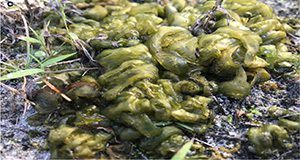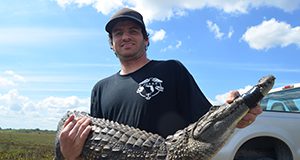Este artículo es escrito para ayudar el lector a entender la biología y ecología de Nostoc, un género común de cianobacteria (alga verdeazulada) de suelos húmidos, y proporcionar métodos para manejar esta plaga en viveros. This 4-page document is the Spanish version of Biology and Management of Nostoc (Cyanobacteria) in Nurseries and Greenhouses. Written by H. Dail Laughinghouse IV, David E. Berthold, Chris Marble, and Debalina Saha, and published by the UF/IFAS Agronomy Department, April 2019.
http://edis.ifas.ufl.edu/ag432
Tag: Ft. Lauderdale REC
Biology and Management of Nostoc (Cyanobacteria) in Nurseries and Greenhouses
This new 4-page document provides an overview of the biology and ecology of Nostoc-like cyanobacteria (blue-green algae) in humid soils and discusses cultural, physical, and chemical methods to manage this weed in nursery environments. Written by H. Dail Laughinghouse IV, David E. Berthold, Chris Marble, and Debalina Saha, and published by the UF/IFAS Agronomy Department, February 2019.
http://edis.ifas.ufl.edu/ag430
Everglades Invasive Reptile and Amphibian Monitoring Program: Summary of the First Five Years
South Florida has more nonnative species of reptiles and amphibians than anywhere else in the world. Some of these species become invasive and harm the environment, economy, and/or public health. Once populations are widely established, management becomes expensive, long-term, and often ineffective. Early detection and rapid response offers the best chance to contain or eradicate populations before they can spread and become unmanageable. Toward that end, the Everglades Invasive Reptile and Amphibian Monitoring Program provides a scientific framework for monitoring invasive reptiles and amphibians in south Florida. It also monitors native reptiles, amphibians, and mammals to assess impacts of invasive species.
This 5-page fact sheet written by Rebecca G. Harvey, Mike Rochford, Jennifer Ketterlin Eckles, Edward Metzger III, Jennifer Nestler, and Frank J. Mazzotti and published by the Wildlife Ecology and Conservation Department lists the objectives, activities, and accomplishments of the program over its first five years, and it describes some ways Floridians and visitors to the state can help with the effort.
http://edis.ifas.ufl.edu/uw431
Not All Landscape Palm Fertilizers Are Created Equal
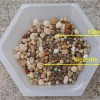 Palms are widely planted in Florida landscapes. Their bold leaf textures create a tropical or Mediterranean look that is highly desired by residents and tourists alike. But palms have very high nutritional requirements, and deficiencies of any element can result in conspicuous and unattractive symptoms on their large leaves. UF/IFAS research shows that the most effective fertilizer has 100% of the N, K, Mg, and B sources in slow-release or controlled-release form and that all of the Mn, Fe, Zn, and Cu sources should be water soluble. This 4-page fact sheet explains the reasons for this recommendation and how to ensure that you have a formulation that will be effective. Written by Timothy K. Broschat, and published by the UF Department of Environmental Horticulture, March 2015. (Photo Credit: T.K. Broschat)
Palms are widely planted in Florida landscapes. Their bold leaf textures create a tropical or Mediterranean look that is highly desired by residents and tourists alike. But palms have very high nutritional requirements, and deficiencies of any element can result in conspicuous and unattractive symptoms on their large leaves. UF/IFAS research shows that the most effective fertilizer has 100% of the N, K, Mg, and B sources in slow-release or controlled-release form and that all of the Mn, Fe, Zn, and Cu sources should be water soluble. This 4-page fact sheet explains the reasons for this recommendation and how to ensure that you have a formulation that will be effective. Written by Timothy K. Broschat, and published by the UF Department of Environmental Horticulture, March 2015. (Photo Credit: T.K. Broschat)
http://edis.ifas.ufl.edu/ep516
The Invasion Curve: A Tool for Understanding Invasive Species Management in South Florida
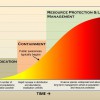 South Florida has more than its share of invasive plants, reptiles, amphibians, fish, mammals, birds, and invertebrates. Nonnative species often spread quickly. Research and monitoring can help managers anticipate which species will cause harm before it is too late to remove them. Identifying where a species is on the invasion curve is the first step to taking management action. The invasion curve shows that eradication of an invasive species becomes less likely and control costs increase as an invasive species spreads over time. Prevention is the most cost-effective solution, followed by eradication. If a species is not detected and removed early, intense and long-term control efforts will be unavoidable. This 4-page fact sheet was written by Rebecca G. Harvey and Frank J. Mazzotti, and published by the UF Department of Wildlife Ecology and Conservation, November 2014.
South Florida has more than its share of invasive plants, reptiles, amphibians, fish, mammals, birds, and invertebrates. Nonnative species often spread quickly. Research and monitoring can help managers anticipate which species will cause harm before it is too late to remove them. Identifying where a species is on the invasion curve is the first step to taking management action. The invasion curve shows that eradication of an invasive species becomes less likely and control costs increase as an invasive species spreads over time. Prevention is the most cost-effective solution, followed by eradication. If a species is not detected and removed early, intense and long-term control efforts will be unavoidable. This 4-page fact sheet was written by Rebecca G. Harvey and Frank J. Mazzotti, and published by the UF Department of Wildlife Ecology and Conservation, November 2014.
http://edis.ifas.ufl.edu/uw392
American Lotus, Yellow Lotus: Nelumbo lutea
 American lotus is an ideal native plant for constructed or restored wetland areas, where it provides shelter, habitat, and food for wildlife. It is an herbaceous aquatic perennial native plant that tolerates a wide range of conditions. The fragrant yellow flowers, huge round leaves, and persistent seed pods borne on stiff stalks high above the water make it both distinctive and visually striking. Native American tribes treated the American lotus as a sacred plant with mystical powers, and many tribes ate the large rhizomes and used parts of the plant for medicinal purposes. This 3-page fact sheet was written by Warner Orozco-Obando and Lyn Gettys, and published by the UF Department of Agronomy, March 2014.
American lotus is an ideal native plant for constructed or restored wetland areas, where it provides shelter, habitat, and food for wildlife. It is an herbaceous aquatic perennial native plant that tolerates a wide range of conditions. The fragrant yellow flowers, huge round leaves, and persistent seed pods borne on stiff stalks high above the water make it both distinctive and visually striking. Native American tribes treated the American lotus as a sacred plant with mystical powers, and many tribes ate the large rhizomes and used parts of the plant for medicinal purposes. This 3-page fact sheet was written by Warner Orozco-Obando and Lyn Gettys, and published by the UF Department of Agronomy, March 2014.
http://edis.ifas.ufl.edu/ag380
Field Production of Palms (ENH1210/EP471)
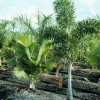 Field production is the most practical means of producing large palm specimens, and it has several advantages over container production. Yield per acre can be maximized compared to many other woody ornamentals because of the columnar growth habit of most palms and their ability to survive transplanting with a minimal root ball. When dug and tied properly, many more palms can be loaded into a standard shipping container than could similarly sized trees. Palms also offer great versatility in the method of field harvesting.This 7-page fact sheet was written by Timothy K. Broschat, Alan W. Meerow, and Jack Miller, and published by the UF Department of Environmental Horticulture, April 2013.
Field production is the most practical means of producing large palm specimens, and it has several advantages over container production. Yield per acre can be maximized compared to many other woody ornamentals because of the columnar growth habit of most palms and their ability to survive transplanting with a minimal root ball. When dug and tied properly, many more palms can be loaded into a standard shipping container than could similarly sized trees. Palms also offer great versatility in the method of field harvesting.This 7-page fact sheet was written by Timothy K. Broschat, Alan W. Meerow, and Jack Miller, and published by the UF Department of Environmental Horticulture, April 2013.
http://edis.ifas.ufl.edu/ep471
Fusarium Wilt of Canary Island Date Palm (PP215/PP139)
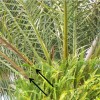 As the name implies, Fusarium wilt of Canary Island date palm is primarily observed on the Canary Island date palm. It was first documented in the United States in the 1970s in California, but it was not documented in Florida until 1994. It now occurs throughout the state. The fungus obstructs the xylem (water-conducting) tissue, which results in desiccation and death. This 5-page fact sheet was written by Monica L. Elliott, and published by the UF Department of Plant Pathology, July 2012.
As the name implies, Fusarium wilt of Canary Island date palm is primarily observed on the Canary Island date palm. It was first documented in the United States in the 1970s in California, but it was not documented in Florida until 1994. It now occurs throughout the state. The fungus obstructs the xylem (water-conducting) tissue, which results in desiccation and death. This 5-page fact sheet was written by Monica L. Elliott, and published by the UF Department of Plant Pathology, July 2012.
http://edis.ifas.ufl.edu/pp139
Bud Rot of Palm (PP220/PP144)
 To understand bud rots, an explanation of palm anatomy is necessary. The growing point of the palm is often called the bud or heart. All leaves originate from there, and each palm stem has only one. Thus, when the bud is damaged or diseased, the palm usually dies. The first symptom is discoloration and wilting of the spear leaf and wilting/discoloration of the next youngest leaf. This 4-page fact sheet was written by Monica L. Elliott, and published by the UF Department of Plant Pathology, July 2012.
To understand bud rots, an explanation of palm anatomy is necessary. The growing point of the palm is often called the bud or heart. All leaves originate from there, and each palm stem has only one. Thus, when the bud is damaged or diseased, the palm usually dies. The first symptom is discoloration and wilting of the spear leaf and wilting/discoloration of the next youngest leaf. This 4-page fact sheet was written by Monica L. Elliott, and published by the UF Department of Plant Pathology, July 2012.
http://edis.ifas.ufl.edu/pp144
The Invasion of Exotic Reptiles and Amphibians in Florida (WEC320/UW365)
 Florida has more introduced species of reptiles and amphibians living and breeding in the wild than anywhere else in the world. This 6-page fact sheet summarizes findings from three recent scientific papers describing who these invaders are, their potential ecological impacts, and recommendations for their management and control. Written by Frank J. Mazzotti and Rebecca G. Harvey, and published by the UF Department of Wildlife Ecology and Conservation, May 2012.
Florida has more introduced species of reptiles and amphibians living and breeding in the wild than anywhere else in the world. This 6-page fact sheet summarizes findings from three recent scientific papers describing who these invaders are, their potential ecological impacts, and recommendations for their management and control. Written by Frank J. Mazzotti and Rebecca G. Harvey, and published by the UF Department of Wildlife Ecology and Conservation, May 2012.
http://edis.ifas.ufl.edu/uw365
Boron Deficiency in Palms (ENH1012/EP264)
 Chronic boron deficiency is believed to be caused by soil drying and high soil pH, while temporary deficiency is caused by heavy leaching. It results in a wide array of symptoms, not only among species of palms, but also within a single species. This 5-page fact sheet contains many illustrations to aid in diagnosis and management recommendations. Written by Timothy K. Broschat and published by the UF Department of Environmental Horticulture, June 2011.
Chronic boron deficiency is believed to be caused by soil drying and high soil pH, while temporary deficiency is caused by heavy leaching. It results in a wide array of symptoms, not only among species of palms, but also within a single species. This 5-page fact sheet contains many illustrations to aid in diagnosis and management recommendations. Written by Timothy K. Broschat and published by the UF Department of Environmental Horticulture, June 2011.
http://edis.ifas.ufl.edu/ep264
Pruning Palms (ENH1182/EP443)
Perhaps the most fundamental question to answer when discussing palm pruning is what should a healthy, properly pruned palm look like? Consumers must be educated that palms are supposed to have round crowns, not feather-duster crowns. Learn more with this 9-page fact sheet written by Timothy Broschat, and published by the UF Department of Environmental Horticulture, April 2011.
http://edis.ifas.ufl.edu/ep443
Checklist of Birds of the Everglades Agricultural Area (CIR1444/UW179)
This revised 10-page fact sheet features a checklist of bird species that have been found during eight years of surveys in the Everglades Agricultural Area. Most birds can be associated with a specific habitat such as sugarcane, sod, rice or flooded fields and other agricultural and human-inhabited areas. Written by Elise V. Pearlstine and Frank J. Mazzotti, and published by the UF Department of Wildlife Ecology and Conservation, November 2010.
http://edis.ifas.ufl.edu/uw179
An Introduction to Freely Available Street Network Data (FOR281/FR343)
Projects in agricultural and natural resource management, urban planning, and community development typically use some kind of spatial data for analysis and mapping. Applications and websites exist which allow the user to view spatial data and perform some basic spatial operations (e.g., compute the distance between two locations). This 6-page fact sheet focuses on data sources that allow users to download free street data for further processing and analysis. Written by Hartwig H. Hochmair and Dennis Zielstra, and published by the UF Department of School of Forest Resources and Conservation, March 2011.
http://edis.ifas.ufl.edu/fr343
PP278 Fusarium Wilt of Queen Palm and Mexican Fan Palm
PP278, a 6-page illustrated fact sheet by Monica L. Elliot, describes this lethal fungal disease affecting primarily queen and Mexican fan palms — pathogen and hosts, symptoms, diagnosis, and disease management. Includes references. Published by the UF Department of Plant Pathology, June 2010.
http://edis.ifas.ufl.edu/pp278
SL321/SS533 Ecological Landscape Modeling: the general application of an existing simulation framework
SL321, an 8-page illustrated fact sheet by H.Carl Fitz, is an overview of an existing, generalized model framework that synthesizes integrated ecosystem dynamics within large spatial domains and across decadal ecological time scales. Includes references. Published by the UF Department of Soil and Water Science, June 2010.
http://edis.ifas.ufl.edu/ss533
SL320/SS532 South Florida Conceptual Model
SL320, a 7-page illustrated fact sheet by H. Carl Fitz, describes this model that explores the fundamental linkages among the Everglades landscape and the human dimension of the South Florida region — societal valuation, urban and agricultural development, water management, and everglades dynamics. Includes references. Published by the UF Department of Soil and Water Science, June 2010.
http://edis.ifas.ufl.edu/ss532
PP-243/PP163 Texas Phoenix Palm Decline
Revised! PP-243, a 5-page illustrated fact-sheet by Nigel A. Harrison and Monica L. Elliott, describes this new systemic disease affecting primarily date palms in Florida, the pathogen and hosts, symptoms, diagnostics, and disease management. Includes references. Published by UF Department of Plant Pathology, February 2009.
http://edis.ifas.ufl.edu/PP163
